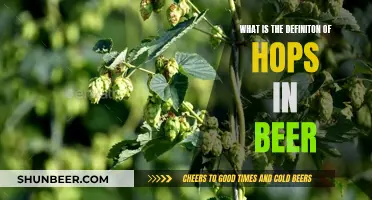
Hops are the flowers of the hop plant, Humulus lupulus, and are used as a bittering, flavouring, and stability agent in beer. They impart bitterness, as well as floral, fruity, or citrus flavours and aromas to beer. Hops also act as a preservative, inhibiting spoilage bacteria and helping to stabilise foam. The hop plant has separate female and male plants, and only female plants are used for commercial production as male plants can cause undesirable pollination.
Hops contain alpha acids or humulones, which are isomerised into iso-alpha acids or isohumulones during the brewing process, and are responsible for the bitter taste of beer. Hops also contain beta acids or lupulones, which contribute to the aroma of beer. The main components of hops essential oils are terpene hydrocarbons, including myrcene, humulene, and caryophyllene.
The addition of hops at different stages of the brewing process can affect the flavour and aroma of the final beer. Hops added at the beginning of the boiling stage add bitterness, while hops added at the end of the boil or during fermentation (a technique known as dry hopping) contribute more to the aroma and flavour.
The stability of beer flavour is a complex topic and can be affected by various factors such as oxygen, light, temperature, and time. Hops can help to improve the shelf life of beer by acting as antioxidants and antimicrobials. However, the degradation of alpha acids and essential oils can occur quickly once hops are exposed to oxygen, and high temperatures can also negatively impact the quality of hops.
| Characteristics | Values |
|---|---|
| Purpose | Hops are added to beer to add bitterness to its flavour and more are added at the end of the boil for aroma and flavour. |
| Preservation | Hops act as a preservative by inhibiting spoilage bacteria during a beer's shelf life. |
| Foam stability | Hops help to stabilise the foam qualities of beer. |
| Antibacterial effect | Hops are used in brewing for their antibacterial effect over less desirable microorganisms. |
| Beer styles | Hops are used in beer styles such as pale lagers, Pilsener, Dunkel, Oktoberfest/Märzen, and India Pale Ale (IPA). |
| Hop types | Bittering hops and aroma hops are the two main types. |
| Hop forms | Hops can be in the form of pellets, plugs, extracts, or cones. |
| Hop varieties | Some popular hop varieties include Hallertau, Tettnanger, Spalt, Saaz, Fuggles, Goldings, and Cascade hops. |
| Alpha acids | Alpha acids or humulones in hops are responsible for the bitter taste of beer. |
| Beta acids | Beta acids or lupulones in hops contribute to the aroma of beer. |
| Essential oils | The main components of hops essential oils are terpene hydrocarbons, including myrcene, humulene, and caryophyllene. |
| Flavonoids | Xanthohumol is the principal flavonoid in hops, with potential benefits under basic research. |
| Hop storage | To preserve the impact of hops in beer, they should be stored in temperatures of 1°C-5°C and sealed in oxygen barrier laminated foils that have been back-flushed with carbon dioxide. |
What You'll Learn

Hops' antibacterial properties
Hops have been used for their medicinal properties for centuries, and their antibacterial properties are well-documented. The female inflorescences (hops) are used in the brewing industry for their bitterness and antiseptic properties.
The antibacterial properties of hops against Gram-positive bacteria have been well-documented. The main bittering components of beer, the isomerised-alpha acids, are also susceptible to ageing. Over time, iso-alpha acids in beer begin to degrade, resulting in decreased beer bitterness.
Hops contain high concentrations of unique "alpha" and "beta" acids that can inhibit the growth of Gram-positive bacteria at low concentrations. The antibacterial properties of hops are attributed to the prenyl group of hop acids, which interferes with the bacterial cell plasma membrane.
Hop extracts have shown activity against a range of bacteria, including:
- Gram-positive bacteria such as Lactobacillus, Streptococcus, Staphylococcus, Listeria, Clostridium, and Bacillus species
- Gram-negative bacteria such as Helicobacter pylori and Brucella species
- Some fungi such as Candida, Trichophyton, Fusarium, and Mucor species
The antibacterial activity of hops can be enhanced or reduced depending on the extraction solvent used. For example, the ethyl acetate, acetone, and methanol crude extracts of spent hops exhibited antifungal activity against Fusarium oxysporum, F. culmorum, and F. semitectum, while the methylene chloride extract exerted antifungal activity against Botrytis cinerea.
Hops also have antiviral properties, inhibiting the replication and proliferation of some viruses such as hepatitis C and human immunodeficiency virus (HIV).
In addition to their antibacterial properties, hops also have anti-inflammatory, antioxidant, and cancer chemopreventive effects.
Hops in Beer: Vegetable or Not?
You may want to see also

Hop acids and beer stability
Hop acids are essential to the organoleptic qualities of beer, including taste and flavour. They are responsible for the typical bitter taste of beer and also contribute to its delicate hoppy flavour.
Hop acids are susceptible to degradation, which impacts both hop storage and the beer-brewing process. Hop beta acids, in particular, are prone to oxidation, which can be initiated by airborne oxygen. This has implications for the stability of the beer.
Hop beta acids are sensitive to oxidation reactions initiated by air. This oxidation occurs during long-term storage of unprocessed raw hops and is almost quantitative during the wort boiling process. The degradation of hop beta acids can result in the formation of hulupones, which have been detected in beers and are estimated to be present in concentrations of 1-2 mg/L. Hulupones have a bitter taste, with a sensory threshold in the range of 8-15 µmol/L.
The degradation of hop beta acids can also lead to the formation of cyclisation products, such as tricyclolupulones and hydroxytricyclolupulones. These compounds have been found to contribute to the bittering potential of beer, with a bittering intensity of approximately 35-40% of the bitterness of iso-alpha acids.
The oxidation of hop beta acids can also impact the antimicrobial properties of the beer. Hop beta acids have been found to exhibit bacteriostatic activity, inhibiting the growth of Gram-positive bacteria. However, their oxidation can reduce this antimicrobial activity.
The degradation of hop beta acids during storage can also impact the sensory qualities of the beer. Beers hopped with partially oxidised beta acids have shown perceptible sensory bitterness. This bitterness was described as pleasant and not clinging.
In summary, the degradation of hop beta acids during storage and the brewing process can impact the stability of the beer by affecting its bitterness, antimicrobial properties, and sensory qualities.
Hops Beer: The Secret Behind the Bitter Buzz
You may want to see also

Hop extraction methods
Hops are the basic raw material for beer production, and their chemical composition is complex, with over 200 known chemical compounds. The special chemical components include bitter substances alpha-acids, β-acids, hops essential oils, and polyphenols. The extraction of hops can be done in various ways, including:
- Pressure rolling hops: This involves drying fresh hops with hot air to a moisture content of 6-8% and then re-pressing them into whole hops.
- Hop pellets: This method dries hops with hot air to a moisture content of 5-6%, then pulverises and granulates them into hop pellets, which are packaged in airtight containers with N2 or CO2 gas protection.
- Hops extract: This process uses CO2 or other solvents to extract the desired compounds from hops. CO2 extraction is the most common method and can be done with liquid or supercritical CO2. The latter is more efficient but requires more robust equipment due to the high pressures involved. The hops extract can then be packaged in cans or small pails for easy dosing into the brew kettle.
The choice of extraction method depends on the specific needs of the brewer and the desired characteristics of the final beer.
Beer Hops Allergy: What You Need to Know
You may want to see also

Hop preservation methods
Hops have been used as a natural preservative and bittering agent in beer. They contain antimicrobial properties that help to inhibit certain types of microbes, such as gram-positive bacteria. The key to preserving hops lies in minimising their exposure to light, heat, and oxygen, as these factors can degrade their quality over time. Here are some methods and guidelines for preserving hops:
Harvesting:
- Hops are typically harvested between mid-August and September when the cones are dry and aromatic.
- Picking the cones by hand is recommended for first-year harvests, while cutting down the bine is suggested for subsequent years.
- To check if the hops are ripe, squeeze a cone gently. If it stays compressed, it's not ready; ripe hops will spring back after a squeeze.
- Ripe hops will also have a pungent smell, somewhere between cut grass and onion.
- The cones should feel light, dry, and papery, with sticky lupulin (a yellow substance) visible on the outside.
Drying:
- Drying hops is crucial to preserving them, but it should be done quickly and at temperatures below 140°F (60°C) to prevent the loss of desired aromatics.
- Various methods can be used for drying, including a food dehydrator, a well-ventilated oven, or a hop-drying screen in a warm and dry location with a fan.
- Drying times can range from 24 to 48 hours, and the hops should have a moisture content of 8% to 10% by weight to prevent moulding.
- Break the central stem of the cone to check if it's dry enough—it should snap in half easily.
Storing:
- Weigh out the dried hops and separate them into small bags to be frozen.
- Remove as much air as possible from the bags before sealing and storing them in the freezer.
- Vacuum sealing is ideal for removing oxygen, the enemy of hop freshness.
- Stored in a cold, dark place, properly dried hops can remain fresh for 6 months to a year.
Where to Find Tropical Hop Beer Near You
You may want to see also

Hop varieties
Hops are the flowers of the hop plant, *Humulus lupulus*, and are used primarily as a bittering, flavouring, and stability agent in beer. They are also used in brewing for their antibacterial effects, which help to protect the finished beer from spoilage.
There are many different varieties of hops used in brewing today, and they can be classified as bittering, aroma, or dual-purpose hops. Bittering hops have higher concentrations of alpha acids and are responsible for the bitter flavour of beer. Aroma hops, on the other hand, have lower concentrations of alpha acids and contribute more to the hop aroma and flavour of the beer. Dual-purpose hops have high concentrations of alpha acids and good aromatic properties, and can be added at any time during the brewing process.
The compounds responsible for the aroma and bitterness of hops are located in the lupulin glands. The main chemical compounds within hops include alpha acids or humulones, beta acids or lupulones, and essential oils such as myrcene, humulene, and caryophyllene.
Some of the most common hop varieties and their characteristics include:
- Hallertau or Hallertauer: The original German lager hop, named after the Hallertau region in central Bavaria. It has a delicate, spicy aroma and soft bitterness.
- Spalt: A traditional German noble hop from the Spalter region, with a delicate, spicy aroma.
- Tettnang: A noble German dual-use hop with a soft bitterness, often used in European pale lagers.
- Žatec (Saaz): A noble hop named after the town of Žatec in Bohemia, used extensively in Czech pale lagers such as Pilsner Urquell. It has a soft aroma and bitterness.
- Cascade hops: Often used in North American beers, with a strong aroma and intense flavours.
Wheat Beer and Hops: An Unlikely Friendship
You may want to see also
Frequently asked questions
Yes, hops are added to beer to act as a preservative and increase its shelf life. Hops contain antibacterial properties that inhibit spoilage bacteria and allow the yeast in the beer to grow. They also add bittering, flavouring, and stability to the beer.
Hops contain alpha acids or humulones that are thermally isomerized into iso-alpha acids or isohumulones during the wort boiling process. These iso-alpha acids are responsible for the bitter taste of beer. Hops also contain beta acids or lupulones that contribute to the aroma of the beer.
To increase the shelf life of hops, they should be sealed in oxygen barrier laminated foils that have been back-flushed with carbon dioxide. They should be stored in temperatures of 1°C-5°C or lower and exposure to oxygen, heat, and light should be avoided.







